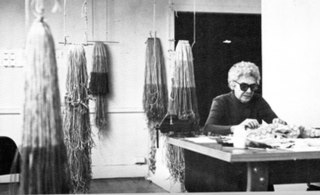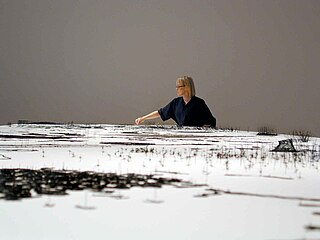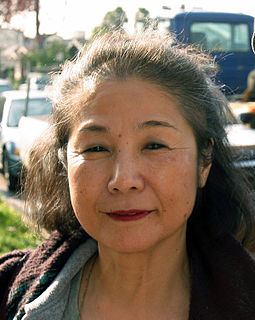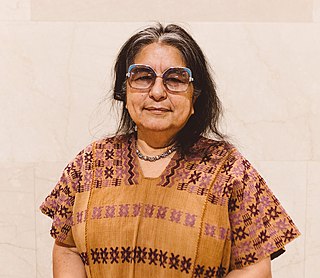Related Research Articles

Fiber art refers to fine art whose material consists of natural or synthetic fiber and other components, such as fabric or yarn. It focuses on the materials and on the manual labor on the part of the artist as part of the works' significance, and prioritizes aesthetic value over utility.

Anni Albers was a German-born American textile artist and printmaker credited with blurring the lines between traditional craft and art.
Besides surface qualities, such as rough and smooth, dull and shiny, hard and soft, textiles also includes colour, and, as the dominating element, texture, which is the result of the construction of weaves. Like any craft it may end in producing useful objects, or it may rise to the level of art.

Lenore Tawney was an American artist known for her drawings, personal collages, and sculptural assemblages, who became an influential figure in the development of fiber art.

Claire Zeisler was an American fiber artist who expanded the expressive qualities of knotted and braided threads, pioneering large-scale freestanding sculptures in this medium. Throughout her career Zeisler sought to create "large, strong, single images" with fiber. Zeisler's non-functional structures were constructed using traditional weaving and avant-garde off the loom techniques such as square knotting, wrapping, and stitching. Zeisler preferred to work with natural materials such as jute, sisal, raffia, hemp, wool, and leather. The textiles were often left un-dyed, evidence of Zeisler's preference for natural coloration that emphasized the fiber itself. When she used color, however, Zeisler gravitated towards red.

Sheila Hicks is an American artist. She lives and works in Paris, France. Prior to that, she lived and worked in Guerrero, Mexico (1959–63). She is known for her innovative and experimental weavings and sculptural textile art that incorporate distinctive colors, natural materials, and personal narratives.
Mary Walker Phillips was an American textile artist, author and teacher. She revolutionized the craft of hand knitting by exploring knitting as an independent art form. In the catalog to her 1984 Fresno Arts Center exhibition, Jack Lenor Larsen described Mary Walker Phillips as the "transition between the old-fashioned, pattern-book knitting and the extraordinary things going on in England and America today." Her hand knit tapestries and other creative pieces are exhibited in museums in the U.S. and Europe.

Anne Wilson is a Chicago-based visual artist. Wilson creates sculpture, drawings, Internet projects, photography, performance, and DVD stop motion animations employing table linens, bed sheets, human hair, lace, thread and wire. Her work extends the traditional processes of Fiber art to other media. Wilson is a professor in the Department of Fiber and Material Studies at The School of the Art Institute of Chicago.
Polly Barton is an American textile artist. She was born in New York City. As a student she studied art history at Barnard College and has lived and traveled in Paris, Florence, and Rome. In 1981, she moved to Kameoka, Japan, to study with master weaver Tomohiko Inoue, living in the religious heart of the Oomoto Foundation. She returned to New York in 1982 and continued to weave on her Japanese tsumugi silk kimono looms.
Bhakti Ziek is an American artist known for narrative weavings incorporating contemporary jacquard technology. She has been active in the contemporary fiber field for over four decades as an artist, author, teacher and lecturer. Ziek currently resides in Randolph, Vermont.
Katherine Westphal was an American textile designer and fiber artist who helped to establish quilting as a fine art form.
Kay Sekimachi is an American fiber artist and weaver, best known for her three-dimensional woven monofilament hangings as well as her intricate baskets and bowls.
Cynthia Schira is an American textile artist and former university professor. Her work is represented in the collections of many major public museums.
Marianne Strengell was an influential Finnish-American Modernist textile designer in the twentieth century. Strengell was a professor at Cranbrook Academy of Art from 1937 to 1942, and served as department head from 1942 to 1962. She was able to translate hand-woven patterns for mechanized production, and pioneered the use of synthetic fibers.
Wini "Akissi" McQueen is an American quilter based in Macon, Georgia. Her artistic production consists of hand-dyed accessories and narrative quilts. Her techniques for her well-known quilts include an image transferring process. In her work, she tackles issues of race, class, society, and women. Her quilts have featured in many museum exhibitions, including the Museum of African American Folk Art, the Taft Museum, the Bernice Steinbam Gallery, and the William College Art Museum. In 2020, her quilts were featured in a retrospective dedicated to her textile art at the Museum of Arts & Sciences in Macon, GA.
Dorothy Caldwell is a Canadian fibre artist. Her work consists primarily of abstract textile based wall hangings that utilize techniques such as wax-resist, discharge dyeing, stitching, mark-making, and appliqué.

Yoshiko Iwamoto Wada is a Japanese textile artist, curator, researcher and author.
Lia Cook is an American fiber artist noted for her work combining weaving with photography, painting, and digital technology. She lives and works in Berkeley, California and is known for her weavings which expanded the traditional boundaries of textile arts. She has been a professor at California College of the Arts since 1976.
Françoise Grossen is a textile artist known for her braided and knotted rope sculptures. She lives and works in New York City. Grossen’s work has been acquired by the Metropolitan Museum of Art, New York; the Renwick Gallery, Smithsonian American Art Museum, Washington, DC; and the State Hermitage Museum, Saint Petersburg, Russia.
Naomi Kobayashi and is a Japanese textiles, paper, installation and sculpture artist.

Consuelo Jiménez Underwood is an American fiber artist, known for her pieces that focus on immigration issues. She is an indigenous Chicana currently based in Cupertino, California. As an artist she works with textiles in attempt to unify her American roots with her Mexican Indigenous ones, along with trying to convey the same for other multicultural people.
References
- ↑ "Adela Akers". Browngrotta.com. Archived from the original on 2016-05-23. Retrieved June 3, 2016.
- ↑ "Artists, Adela Akers". FiberScene.com. Archived from the original on 2016-12-11. Retrieved 2015-05-07.
- ↑ Carr, Jr., Francis (19 April 2015). "Historic Wilton Barn Hosts Rare Fiber Art Exhibition". The Hour. Retrieved 2 May 2015.
- ↑ "Night Pyramid Adela Akers". metmuseum.org. The Metropolitan Museum of Art. Retrieved 22 January 2014.
- ↑ Archives of American Art. "Summary of the Adela Akers papers, 1960-2009". Archives of American Art. Smithsonian Institution. Retrieved 2014-03-19.
- 1 2 3 4 5 6 7 8 9 10 11 12 13 Riedel, Mija (March 2008). "Oral history interview with Adela Akers, 2008 March 4-6". Archives of American Art. Smithsonian Institution. Retrieved 2 May 2015.
- ↑ "Adela Akers". Spark. KQED Public Media. May 2007. Archived from the original on 2011-11-23. Retrieved 2014-03-19.
- ↑ "Summary of the Adela Akers papers, 1960-2009". Archives of American Art. Smithsonian Institution. Retrieved 2015-05-07.
- ↑ "Stimulus Exhibition at browngrotta arts in October Features Art Textiles, Ceramics and Sculpture by 55 International Artists". PR Web. 26 September 2011. Retrieved 2 May 2015.
- 1 2 "August Artist-in-Residence: Adela Akers: Traced Memories". de Young Artist Studio. Retrieved June 3, 2016.
- ↑ "Snyderman-Works Galleries". Snyderman-works.com. Retrieved 2015-05-07.
- ↑ "Current - Snyderman-Works Galleries". Snyderman-works.com. 2015-05-01. Retrieved 2015-05-07.
- ↑ "Fiber Art by Adela Akers". Sonoma County Museum. Archived from the original on February 2, 2016. Retrieved June 3, 2016.
- ↑ "Adela Akers, Textiles". Archived from the original on April 19, 2010. Retrieved July 18, 2011.
- ↑ "Adela Akers, Recent Works". Archived from the original on September 28, 2011. Retrieved July 18, 2011.